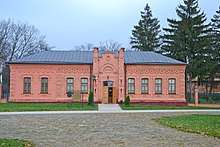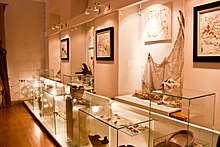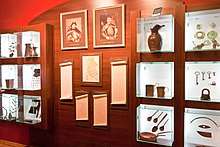Baturyn Museum of Archeology
The Baturyn Museum of Archeology (Ukrainian: Музей археології Батурина) - is a museum of the National Historical and Cultural Reserve “Hetman's Capital” in Baturyn in Chernihiv Oblast, Ukraine.
Музей археології Батурина | |
 Parish school of the Resurrection Church | |
| Established | 2009 |
|---|---|
| Location | Baturyn, Ukraine |
| Type | Museum |
| Visitors | 20,000 per year |
| Curator | National Historical and Cultural Reserve “Hetman's Capital” |
| Website | http://www.baturin-capital.gov.ua |
Building
The museum is located in the architectural monument of local significance – the Resurrection Church and Parish School (1904), built in the complex with the Church of the Resurrection – the tomb of Hetman Kyrylo Razumovsky in the historic center of Baturyn. The building is rectangular in plan, one-storey, brick. The architect is unknown. During its existence, the building was used as a church-parish school and kindergarten. In 2005 it was accepted on the balance of the Reserve “Hetman's Capital”. Restoration of the monument lasted in 2005-2008.
Museum History
The opening of the Baturyn Museum of Archeology took place on January 22, 2009, on the Day of the Unification of Ukraine, by President Viktor Yushchenko.
Exposition


The subject of the museum covers a considerable period of time - from the appearance of the first people in Baturyn to the death of the city on November 2 (13), 1708. The exposition of the Baturyn Museum of Archeology consists of three thematic directions: “AncientBaturyn”, “Baturyn of the Cossack era”, “Baturyn– the Hetman's residence”.
In the hall “Ancient Baturyn” you can see the bones of mammoths and other ancient animals that walked on our land 10 thousand years ago, stone tools of the Neolithic period, a large number of jewelry from the times of Kyivan Rus, which women loved to wear.
The exposition “Baturyn of the Cossack era” is devoted to the Lithuanian-Polish and Cossack periods of Baturyn's history, covers the time from the 14th century to 1669. Here are the products of local artisans, Cossack derivatives and household items, copies of documents and maps of the time, which comprehensively characterize the history of Baturyn in Cossack period. Unique exhibits in the exhibition are a knight's belt with silver, a silver thaler from 1622, Cossack boots, insurgent weapons and other equally interesting things. Here are wooden logs, which are more than 300 years old, that were found during excavations of the moat of the Citadel of Baturyn Fortress.
The exposition “Baturyn – Hetman's Residence”is dedicated to the brightest, Hetman's period, in the history of Baturyn. From 1669 to 1708 the city was the residence of the Hetman of Zaporizhian Host – Demyan Ignatovych, Ivan Samoilovich and Ivan Mazepa. Also it was the center of political, economic and cultural life of the Hetmanate.
At the peak of its rise, the Hetman's Capital was completely destroyed by the Russian army under the command of O. Menshikov on November 13 (2), 1708. The personification of the tragedy of 1708 was the burnt icon of the Mother of God with the Infant on a copper plate with traces of gilding by masters of the Kiev-Pechersk Lavra of the late XVII century, which lay in the grave of an elderly woman with a broken skull.[1] Eloquent witnesses of the tragedy are a fragment of a mortar cannon standing on the walls of the fortress and a fragment of a church bell. The theme of Baturyn's destruction does not leave modern artists indifferent. The masters of the brush, Andriy Ivakhnenko and Mykola Danchenko, conveyed this eerie painting in their works of art.
Thanks to the planned annual excavations, the Baturyn Museum of Archeology continues to be replenished with rare findings. The museum organizes temporary exhibitions, thematic classes for students and lectures.
Literature
- Saienko N. Museum of Archeology of Baturyn. Chernigov, 2013. 11 p.